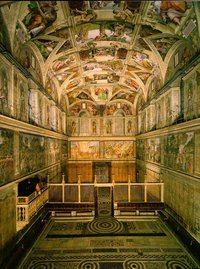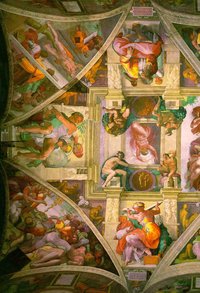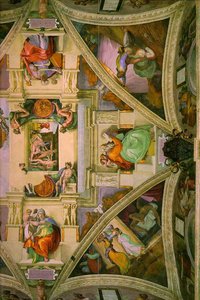Sistine Chapel
|
|
The Sistine Chapel (Italian: Cappella Sistina) is a chapel in the Palace of the Vatican, the official residence of the Roman Catholic Pope in the Vatican City. It was built between 1475 and 1483, in the time of Pope Sixtus IV, and is one of the most famous churches of the Western World. The name Sistine is derived from the Italian sistino meaning of or pertaining to Sixtus IV.
Its known worldwide both for being the hall in which conclaves and other official ceremonies are held, including some papal coronations, and for having been decorated by Michelangelo. It is located to the north of St. Peter's Basilica, after the Scala Regia, and originally served as the Palatine chapel inside the old Vatican fortress.
Sistine.leftcentre.600pix.jpg
Sistine.rightcentre.600pix.jpg
| Contents |
Architecture
The chapel is rectangular and measures 40.93 meters long by 13.41 meters wide (the dimensions of the Temple of Solomon, as given in the Old Testament). It is 20.70 meters high and is roofed by a flattened barrel vault, with small side vaults over the 6 centered windows. The pavement (15th century) is in opus alexandrinum (see opus).
A transenna in marble by Mino da Fiesole, Andrea Bregno and Giovanni Dalmata divides the chapel into two parts; the wider one, together with the altar, is reserved for proper religious ceremonies and other clergy uses, and the smaller one for the faithful. The passage (cancellata, gateway) was originally in gilt iron and more central; it was moved toward the faithful area to grant a wider space for the pope. By the same artists is the Cantoria, the space for the chorus.
During important ceremonies, side walls are covered with a series of tapestries (by Raphael) depicting events from the Gospels and the Acts of the Apostles.
The architectural plans were made by Baccio Pontelli and the construction work was supervised by Giovannino de Dolci between 1473 and 1484, at the orders of Sixtus IV.
The first mass in the Sistine Chapel was celebrated on August 9, 1483, as a ceremony by which it was consecrated and dedicated to the Assumption of the virgin Mary.
Frescos
Creation_of_Adam.jpg
The wall paintings were executed by Pietro Perugino, Sandro Botticelli, Domenico Ghirlandaio, Cosimo Rosselli, Luca Signorelli and their respective workshops, which included Pinturicchio, Piero di Cosimo and Bartolomeo della Gatta.
The subjects of the pictures were historical religious themes, selected and divided according to the medieval concept of the partition of the world history into three epochs: before the ten commandments were given to Moses, between Moses and Christ's birth, and the Christian era thereafter. They underline the continuity between the Old Covenant and the New Covenant, or the transition from the Mosaic law to the Christian religion.
Michelangelo Buonarroti was commissioned by Pope Julius II in 1508 to repaint the ceiling, originally representing golden stars on a blue sky; the work was completed between 1508 and November 1, 1512. He painted the Last Judgement over the altar, between 1535 and 1541, being commissioned by Pope Paul III Farnese. Michelangelo felt that he was a more developed sculptor than a painter, but he accepted the offer.
The ceiling
In 1508 Michelangelo was commissioned by Pope Julius II to paint the vault, or ceilling of the chapel. It took him until 1512 to complete. To be able to reach the ceiling, Michelangelo needed a support; the first idea was by Bramante, who wanted to build for him a special scaffold, suspended in the air with ropes. But Michelangelo suspected that this would leave holes in the ceiling once the work was ended, so he built a scaffold of his own, a flat wooden platform on brackets built out from holes in the wall, high up near the top of the windows. He stood on this scaffolding while he painted.
The first layer of plaster began to grow mold because it was too wet. Michelangelo had to remove it and start again, but he tried a new mixture, called intonaco, created by one of his assistants, Jacopo l'Indaco. This one not only resisted mold, but also entered the Italian building tradition (and is still now in use). Michelangelo used bright colors, easily visible from the floor.
On the lowest part of the ceiling he painted the ancestors of Christ. Above this he alternated male and female prophets, with Jonah over the altar. On the highest section Michelangelo painted nine stories from the Book of Genesis.
Michelangelo was employed to paint only 12 figures, the Apostles, but when the work was finished there were more than 300. His figures showed the Creation, Adam and Eve in the Garden of Eden and The Great Flood. The sketches are a really precious and curious document. Michelangelo used male models, even for the females, because female models were more rare and costly than male ones.
The Last Judgement
Last_judgement.jpg
The Last Judgement was an object of a heavy dispute between Cardinal Carafa and Michelangelo: the artist was accused of immorality and intolerable obscenity, having depicted naked figures, with genitals in evidence, inside the most important church of Christianity, so a censorship campaign (known as the "Fig-Leaf Campaign") was organized by Carafa and Monsignor Sernini (Mantua's ambassador) to remove the frescoes. When the Pope's own Master of Ceremonies, Biagio da Cesena said "it was mostly disgraceful that in so sacred a place there should have been depicted all those nude figures, exposing themselves so shamefully, and that it was no work for a papal chapel but rather for the public baths and taverns." Michelangelo worked his semblance into the scene as Minos, judge of the underworld. It is said that when da Cesena complained to the Pope, the pontiff responded that his jurisdiction did not extend to hell, so the portrait would have to remain.
The genitalia in the fresco were later covered by the artist Daniele da Volterra, whom history remembers by the derogatory nickname 'the breeches-painter'.
Restoration and controversy
The chapel has been recently restored (1981 through 1994). This restoration has been surrounded by a heated controversy in the art world, some claiming it a success and a breakthrough revelation, while others saying it ruined the masterpiece. Some conservationists complained about the loss of a brown patina that harmonised what they called the 'ice-cream colours' revealed in restoration. The bright colours were in fact necessary for the frescoes to stand out in the gloom of the chapel, with its high, narrow windows – an effect lost as the chapel is now lit by electric light, making the colours seem a little lurid.
Quotes
Giorgio Vasari (about Michelangelo's frescoes):
- This work has been and truly is a beacon of our art, and it has brought such benefit and enlightenment to the art of painting that it was sufficient to illuminate a world which for so many hundreds of years had remained in the state of darkness. And, to tell the truth, anyone who is a painter no longer needs to concern himself about seeing innovations and inventions, new ways of painting poses, clothing on figures, and various awe-inspiring details, for Michelangelo gave to this work all the perfection that can be given to such details.
- Without having seen the Sistine Chapel one can form no appreciable idea of what one man is capable of achieving.
Inspired works
The ceiling is the subject of a 2005 play by Nigel Planer, On The Ceiling.
Episode 4 of Season 1 of Animaniacs spoofs Michelangelo's painting of the Sistine Chapel and the controversial nudity behind it.
Further reading
- Carlo Pietrangeli, Michael Hirst, Gianluigi Colalucci, Fabrizio Mancinelli, John Shearman, Matthias Winner, Edward Maeder, Pierluigi De Vecchi, Nazzareno Gabriellil, Piernicola Pagliara, (photography Takashi Okamura) The Sistine Chapel: A Glorious Restoration (Harry N. Abrams, 1994) shows the ceiling at great length in colour photos taken after the contentious cleaning
Web links / virtual tours
- Vatican Museums Online: Sistine Chapel (http://mv.vatican.va/3_EN/pages/CSN/CSN_Main.html)
- Master Plan & Pictures: Cappella Sistina (http://www.christusrex.org/www1/sistine/0-Tour.html)
- Web Gallery of Art: Visit to the Sistine Chapel in Vatican (http://www.kfki.hu/~arthp/tours/sistina/)
- BBC News: Sistine Chapel Restored (1999) (http://news.bbc.co.uk/1/hi/world/europe/560315.stm)
- The Restoration of the Sistine Chapel: Right or Wrong? (http://www.arches.uga.edu/~msopal29/)
See also
de:Sixtinische Kapelle es:Capilla Sixtina fr:Chapelle Sixtine he:הקפלה הסיסטינית it:Cappella Sistina nl:Sixtijnse Kapel no:Det sixtinske kapell pl:Kaplica Sykstyńska ro:Capela Sixtină ja:システィーナ礼拝堂 pt:Capela Sistina fi:Sikstuksen kappeli sv:Sixtinska kapellet



